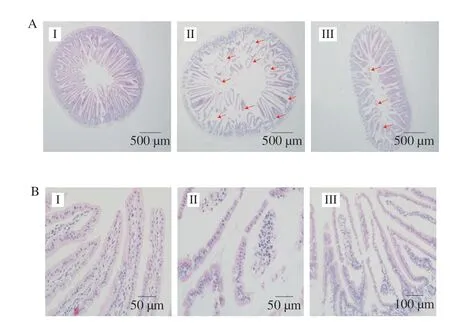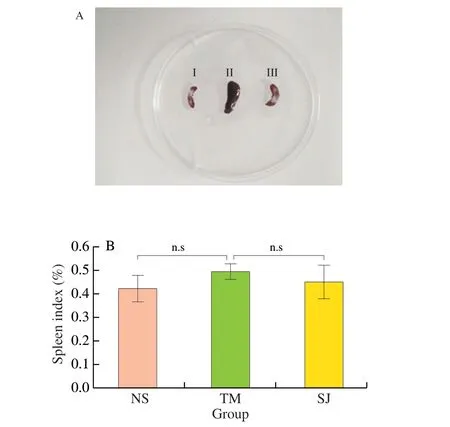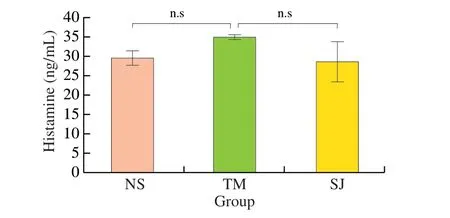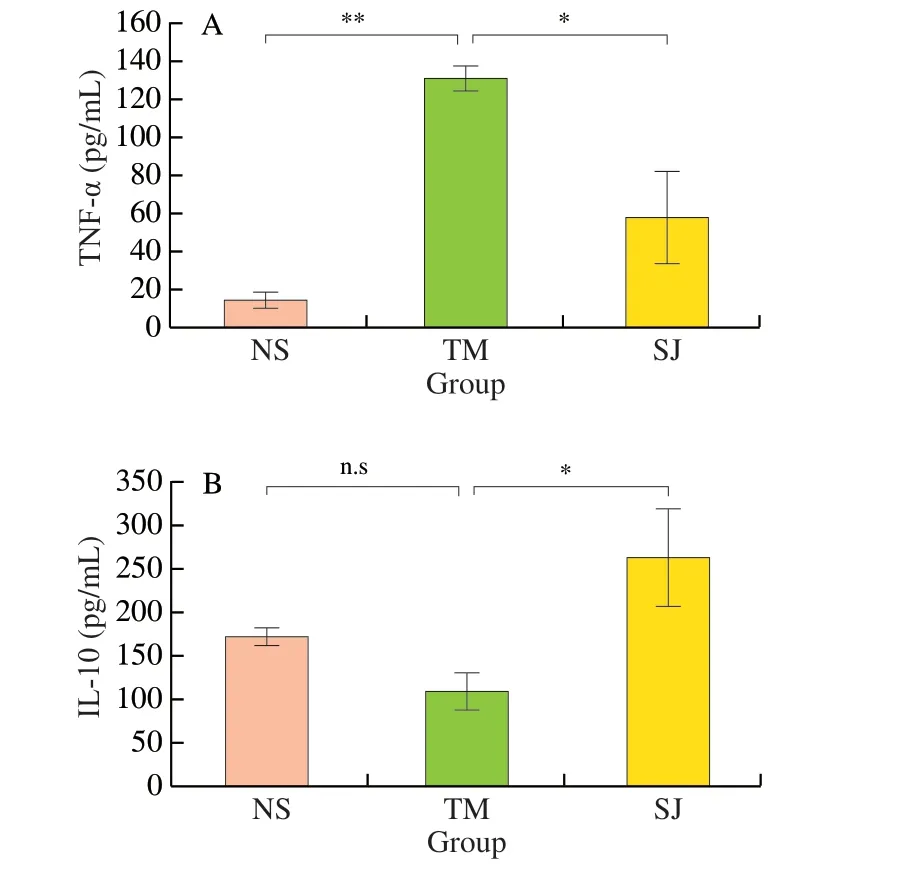Seabuckthorn juice alleviates allergic symptoms in shrimp-induced food allergy mice
Hong Ren, Xiofn Zhu, Shiyu Zhi, Xioping Feng, Zhuomin Yn, Jio Sun,Ye Liu, Zhenpeng Go, Fngyu Long,*
a College of Food Science and Engineering, Northwest A&F University, Yangling 712100, China
b Department of Breast Surgery, The Aff iliated Hospital of Qingdao University, Qingdao 266000, China
c China-Canada Joint Laboratory of Food Nutrition and Health (Beijing), Beijing Technology & Business University, Beijing 100048, China
Keywords:Shrimp Seabuckthorn juice Allergy BALB/c mouse model
A B S T R A C T Tropomyosin (TM) in shrimp is one of the predominant causes of food allergy around the world. In the present study, the effect of seabuckthorn juice against TM-induced shrimp allergy was investigated in BALB/c mice.Allergic symptoms, spleen index, intestinal section and diarrhea were measured in shrimp allergy mice. As the results, seabuckthorn juice suppressed the lesions in jejunum tissue, diarrhea and allergic symptoms in shrimp allergy mice. Seabuckthorn juice also reduced serum concentrations of tumor necrosis factor-α (TNF-α) as well as immunoglobulin E (IgE) and stimulated the secretion of interleukin-10 (IL-10) in mice with shrimp allergy. Taken together, our f indings suggest that increased IL-10 by seabuckthorn juice inhibits Th2 cytokine production to suppress shrimp allergic symptoms. Furthermore, seabuckthorn juice also regulates shrimp allergy by reducing jejunum lesions, inhibiting levels of TNF-α and IgE.
1. Introduction
As the leading cause of anaphylaxis, food allergies remain an emerging health concern throughout the globe [1]. Food allergy not only interferes with the quality of life but also can cause anaphylactic shock, and endanger life in severe cases. The prevalence of food allergy in Europe is reported to be almost 6% in adults [2]. According to a survey in 2013, the population with food allergies in Europe has increased signif icantly compared to 2001, accounting for 17.3% [3].Food allergies result from the exposure to allergens, including milk,egg, wheat, soy, f ish, peanuts, tree nuts, and shellf ish [4]. Among food allergies, shrimps are one of the most common. However, an increase in shrimp consumption has seen a concomitant rise in associated shrimp allergies, especially in coastal countries [5], and shrimp allergies are frequently associated with urticaria, atopic dermatitis, and asthma. The major shrimp allergen is tropomyosin (TM) [6], which caused at least 80% of individuals with shrimp allergies react to TM.With good stability, even after being boiled in water, TM maintains its activity [7]. To date, strict dietary restriction of causative foods is the main cure [8]. Additionally, complete elimination of the food allergen is often diff icult due to its widespread use in processed food.Therefore, it is necessary to explore new methods for ameliorating allergic responses.
Seabuckthorn (Hippophae rhamnoides) was a functional homology plant of medicine and food, which is well documented in Asia and Europe, including China, Mongolia, Russia, Northern Europe, and Canada. Approximately 90% of the total cultivation of seabuckthorn was found in China [9]. The soft parts of the seabuckthorn berry are rich in nutrients and bioactive substances,such as vitamin C, organic acids, carotenoids and flavonoids.Among the above active substances, flavonoids have been proven to have antiallergic effects. Food allergy is an IgE-mediated immune response, pathologically comprising the sensitization and the effector phases, which were both possessed by flavonoids. The inhibition by flavones of transport ATPase in histamine release from rat mast cells was confirmed [10]. Meanwhile, flavonoids could also inhibit the release of histamine, hexosaminidase, and cyteinyl leukotrienes in rat mast cells [11]. Furthermore, flavonoids were found to inhibit the synthesis of tumor necrosis factor-α (TNF-α) and interleukin (IL)-6 production in the mast cells [12]. Subsequently, Tanaka et al. [13]identified the anti-allergic activities of flavonoids in wine through inhibiting IgE synthesis, activation of mast cells and production of inflammatory mediators. In summary, flavonoids could potentially constitute important therapies for treating food allergies.
Seabuckthorn has been increasingly recognized as the potential source of bioactive ingredients for functional foods. Recently,seabuckthorn juice is one of the major sources of flavonoid intake.However, it is currently unclear if seabuckthorn juice possesses an anti-allergic activity of food allergy. To clarify this, a BALB/c mouse model of IgE-mediated anaphylaxis in response to shrimps was created, which will test the hypothesis that seabuckthorn juice may be a functional production of anti-allergic and immunomodulatory activities.
2. Materials and methods
2.1 Raw material and chemicals
Live white shrimps (Litopenaeus vannamei) were purchased in the local aquatic produce market. Fresh shrimps were dissected immediately after removal from the vessel and digestive tracts.1,4-Dithiothreitol, KCl, Na2HPO4, Na2CO3, and NaHCO3were obtained from Aladdin (Shanghai, China). Tris-HCl was acquired from Solarbio (Beijing, China). Acetone was purchased from Xilong Scientific (Sichuan, China). All chemicals were an analytical grade or better.
2.2 Preparation of shrimp TM extracts and seabuckthorn juice
Shrimp TM extracts were prepared as described previously with minor modifications [14]. Raw shrimp muscles were minced and homogenized with 10-fold of 20 mmol/L Tris-HCl (pH 7.5) containing 50 mmol/L KCl. After centrifugation (Anhui USTC Zonkia Scientific Instruments Co., Ltd., Anhui, China) at 10 000 ×gfor 15 min,the supernatant was discarded and the pellet was resuspended in the above buffer, followed by homogenization and centrifugation. The washing, homogenization and centrifugation were repeated 4 times to remove sarcoplasmic proteins effectively. The final resulting precipitate was washed with absolute acetone 3 times. After the final wash, the residues were spread on a filter paper and dried overnight [15]. The dried powder was suspended in a 10-fold (m/V)extraction buffer (1.0 mol/L KCl and 0.5 mmol/L 1,4-dithiothreitol,pH 7.0), and extraction was carried out with constant stirring at 4 °C for 16 h. The solution was centrifuged at 15 000 ×gand 4 °C for 15 min. The supernatant was dialyzed in 0.01 mol/L PBS (pH 7.0) at 4 °C for 48 h, the dialyzed solution containing TM was passed through filter papers, then lyophilized using a vacuum freeze drier and stored at -20 °C, and the powder was diluted to 2 mg/mL with PBS (pH 7.0) for the further treatment. The purity of TM was more than 80%. The protein content was determined using the BCA protein quantification method with BSA as standard.
Seabuckthorn juice was purchased from Gaoyuan Shengguo Seabuckthorn Products Co., Ltd. (Beijing, China). The fresh seabuckthorn berries were frozen immediately after picking and kept at -20 °C. Frozen seabuckthorn fruits are thawed, and subjected to juice extraction and filtration, which was stored at 4 °C in a glass bottle during the oral gavage for the mice. The significant functional components of seabuckthorn juice are flavonoids and ascorbic acid.
2.3 Experimental animals
This study was carried out in accordance with the recommendations of the Animal Ethics Procedures and Guidelines of the People’s Republic of China. All efforts were exerted to minimize the suffering of animals. The animal experiments were approved by the Ethics Committee of Northwest A&F University.
BALB/c mice (female, 6 weeks old) were obtained from Chongqing Tengxin Biotechnology Co., Ltd. Xi’an Branch, then housed in a temperature-controlled room ((25 ± 2) °C) with a 12 h light/12 h dark cycle, and acclimated to the new environment for at least one week prior to experimentation, the animals were allowed free access to sterilized food and autoclaved water.
The mice were randomly divided into the following groups:nonsensitized (NS), TM-sensitized (TM), seabuckthorn juice-treated and TM-sensitized (SJ). Except for the NS group, each mouse was injected PBS with 150 µg of TM in a total volume of 200 µL of PBS containing 1 mg Al(OH)3on days 7, 14 and 21, mice from NS group were injected with equal volume of PBS. Mice from SJ group were administered with 2% seabuckthorn juice dissolved in PBS via oral gavage per day for the duration of the last 2 weeks. Equal amounts of PBS were received in negative NS and TM groups. The mice were sacrificed 24 h post the last gavage; serum samples, the spleen and jejunum tissues were collected and stored at 120 °C for further experiments.
2.4 Clinical signs of mice
Clinical score was estimated as follows: 0, no symptoms;1, scratching around nose and head; 2, puffiness around the eyes and mouth, reduced activity; 3, wheezing, labored respiration, and cyanosis around mouth and tail; 4, no activity after prodding or tremor and convulsion; 5, death [16]. Total scores were obtained by adding scores for individual signs.
2.5 Spleen index
Animals were sacrificed and spleens were collected, which were weighed to calculate the spleen index. The spleen index was determined as the ratio of the spleen weight against the weight of the mouse [17], which was used as one of the indicators to reflect the immune response level of the body to allergens.
2.6 Jejunum histopathology
Jejunum were separated and stored in 4% paraformaldehyde for histopathology, and then the tissue was dehydrated by the stepwise increased concentration of ethanol (70%-100%). Next, the tissue was washed twice with xylene for 3 min, and then embedded in paraffin. Samples were then sectioned at 5 µm thickness before being stained with hematoxylin and eosin (H&E), and subsequently examined by light microscopy (Olympus Co., Tokyo, Japan) for histopathologic evaluation [18].
2.7 Measurement of specific IgE in serum
TM-specific IgE level was measured by enzyme-linked immunoassay (ELISA) (Greiner Bio-One, Frickenhausen, Germany),according to the previously reported method [19]. Briefly, a microtiter plate was coated with 100 µL TM (5 μg/mL) per well in 0.05 mol/L carbonate/bicarbonate buffer (pH 9.6) overnight at 4 °C. On the next day, the plate was washed five times with PBS containing 0.05%Tween-20 and blocked for 1 h at 37 °C. Then, serum samples (1:10 dilutions) were added to the plate and incubated overnight at 4 °C.The plate was incubated with 100 µL of peroxidase-labeled rat monoclonal anti-mouse IgE (1:6 000 dilutions) for 1 h at 37 °C. After that, the plate was washed five times and TMB substrate solution was added, then stopped with the addition of H2SO4. All analyses were performed in triplicate and the mean values were used. Absorbance was measured at 450 nm in ELISA microplate reader.
2.8 Analysis of histamine and cytokine in serum
The blood samples obtained from the retro-orbital plexus were centrifuged at 3 000 r/min for 10 min and stored at -20 °C until analysis. Histamine and TNF-α, IL-10 levels were measured using ELISA kits (Histamine EIA, LDN Labor Diagnostika Nord,Nordhorn, Germany). Those ELISA analyses were performed according to the manufacturer’s protocol. Briefly, the histamine and other cytokines standards of known concentration were provided according to the manufacturer. Quantification of unknown samples was achieved by comparison of their absorbance with the reference curve. Serum samples (1:10 dilutions) were run in triplicate wells along with the standards [20].
2.9 Statistical analysis

Fig. 1 The diarrhea symptom (A, B) and clinical score (C) after the repeated TM challenge for 30-60 min. I, II, III mean NS, TM, SJ, respectively. Data were presented as the mean ± SD obtained from 3 individual experiments (n = 8), where ** means the difference is significant at the level of 0.01.
Data were presented as mean ± SD. A statistical package program(SPSS 25.0) was used to carry out one-way ANOVA analyses and statistical comparisons (Duncan’st-test) among mice groups. In all comparisons, *P< 0.05 and **P< 0.01 were used to determine statistical significance.
3. Results and discussion
3.1 Seabuckthorn juice alleviates allergic symptoms in TM-induced food allergy mice
The mouse model of TM allergy was used to determine whether seabuckthorn juice could affect allergic symptoms. The characteristics of type 1 hypersensitivity reactions were exhibited including slight diarrhea after the repeated TM challenge for 30-60 min. And the funicular from feces was observed in Fig. 1A-B,which indicated the abnormal intestinal reaction. Furthermore,compared to the NS group, the TM group led to higher clinical scores such as reduced activity with increased respiratory rate and wheezing (P< 0.05) (Fig. 1C). The results were in line with the previous study [16,21], which showed the TM-allergy mice model was preliminarily set up. Although systemic anaphylaxis was induced in sensitized mice via TM challenge, the symptom score increased by TM challenge was also significantly inhibited by seabuckthorn juice. Although, TM induced diarrhea, the reduced occurrence was observed with the administration of seabuckthorn juice. Indeed,allergy is one of the clinical manifestations of patients with immune dysregulation, which was ameliorated through specific Treg-based immunotherapies. Geetha et al. [22] also support the view that the extracts of seabuckthorn have immunomodulating activity through T lymphocyte. Taken together, our results suggested that seabuckthorn juice has an effect of suppressing food allergy, which was related to the immunoregulation effect of seabuckthorn.
3.2 Histopathologic analysis of intestine after oral seabuckthorn juice challenge in sensitized mice
Food allergies result in decreased intestinal absorption capacity and increased permeability [23], then, allergy symptoms including diarrhea occurs. It has been demonstrated that intestinal anaphylaxis is associated with the release of histamine and other mediators [24]. In order to investigate alteration of seabuckthorn juice-induced immune response to relieve the symptoms of intestinal tract, the morphology was further observed. Compared to the NS group, the intestinal mucosa as well as the villi were obviously damaged, swelled, and the numbers significantly decreased (Fig. 2) in the TM group. In line with Li et al. [19] who demonstrate that intestinal anaphylaxis occurred after intragastric challenge with cow’s milk and the small intestines revealed marked vascular congestion and edema of the lamina propria through the histologic examination. Meanwhile, the morphology of the intestinal mucosa was obviously restored through the repeated administration of seabuckthorn juice, accompanied with integral mucosa, fitly arranged intestinal villi and integral tissue structures.Shi et al. [25] demonstrated the protective effects of seabuckthorn pulp against radiation-induced acute intestinal injury. Therefore,we concluded that seabuckthorn juice intervention could alleviate anaphylactic reactions including diarrhea and clinical scores through repairing the integral mucosa.

Fig. 2 The images of jejunal histopathology under 40-fold (A) and 200-fold(B) microscope. I, II, III mean NS, TM, SJ, respectively. Data were presented as the mean ± SD obtained from 3 individual experiments (n = 8).
3.3 Effects of seabuckthorn juice on the spleen index
As the largest immune organ on the blood circulation pathway in the body, the spleen can produce immunocompetent molecules including various types of immunoglobulin and effector cells after being stimulated by antigen, involving in immune response.When foreign antigens appear in blood, antigen presenting cells such as macrophages in the spleen will swallow foreign antigens,causing immune responses and changes in the shape and weight of the spleen, so changes in splenic shape and the spleen index were taken as indexes for assessing the sensitizing effect [26]. Although,it did not reach a significant level, an increase in spleen size after sensitized with TM (Fig. 3A) compared to the non-sensitized group, which showed TM treatment induced splenomegaly. And the spleen index increased to a certain degree and the spleen index of allergic mice decreased partially after seabuckthorn juice intervention (Fig. 3B). The seabuckthorn including flavonoids have anti-oxidative activities and immunity enhancing properties [9], which maybe accelerate the recovery of spleen index in the TM-sensitized mice.

Fig. 3 Effects of seabuckthorn juice on spleen size (A) and spleen index (B).I, II, III mean NS, TM, SJ, respectively. Data were presented as the mean ± SD obtained from 3 individual experiments, where n.s.means not significant (n = 8).
3.4 Seabuckthorn juice inhibits the production of IgE in TM-induced food allergy mice
The characterized type 1 hypersensitivity responses mediated by IgE antibodies play an important role in the induction of allergic response [27]. In addition, increased serum IgE levels have been suggested as being predictive parameters of hypersensitivity [28].Repeated administration of food allergy including ovalbumin, peanut and walnut led to allergies with higher IgE levels [20,21,29]. Similar results were confirmed in the present study (Fig. 4), the levels of IgE were significantly increased in TM-induced food allergy mice compared to the normal mice (P< 0.01). Furthermore, we examined whether seabuckthorn juice inhibits the production of antibodies in TM-induced food allergy mice. And results showed that the IgE levels in serum were decreased by the administration of seabuckthorn juice(P< 0.05). The antianaphylaxis in seabuckthorn juice was related to the function of potential immunomodulatory [30-32]. However, further studies are needed to better elucidate the interaction mechanism.

Fig. 4 Effects of seabuckthorn juice on total serum IgE levels. The amounts of mouse specific IgE was measured after the final challenge of TM. Data were presented as the mean ± SD obtained from 3 individual experiments(n = 8), where * and ** mean the difference is significant at the level of 0.05 and 0.01, respectively.
3.5 Effects of seabuckthorn juice on the production of histamine in TM-induced food allergy mice
Serum levels of histamine were also increased in shrimp allergy mice compared to the normal mice, which is a critical mediator that causes allergic symptoms in food allergy [33], studies have shown that several allergens including shrimp, peanut and walnut led to allergies with higher histamine levels through repeated administration [14,20,21].Conversely, further studies showed that histamine release did not appear to play a significant role in the ovalbumin-allergen-induced diarrhea, which was dependent on synergistic signaling induced by serotonin and platelet-activating factor [29]. The serum concentration of histamine was also decreased in the group administered with seabuckthorn juice, but there was no statistical significance (Fig. 5),indicating that evident positive response. Therefore, further study on serotonin, platelet-activating factor and inflammatory cytokine is a need to be elucidated, which maybe clarify the mechanism of the food allergy-induced diarrhea.

Fig. 5 Effects of seabuckthorn juice on histamine levels in the serum. The amounts of histamine were measured after the final challenge of TM. Data were presented as the mean ± SD obtained from 3 individual experiments,where n.s. means not significant (n = 8).
3.6 Seabuckthorn juice inhibits the production of TNF-α and stimulates the production of IL-10 in TM-induced food allergy mice
Food allergy is well known as a Th2-mediated immune response caused by food antigens, in which Th2 cells play an essential role in the induction of IgE in the sensitization phase [34,35]. TNF-α is widely investigated pro-inflammatory cytokine, which can mediate inflammatory responses [36]. IL-10 is a well-known antiinflammatory cytokine that suppresses Th2 immune responses [37].TM-sensitization significantly elevated the serum TNF-α level (Fig. 6A)and reduced the serum IL-10 level (Fig. 6B) as compared to the NS group. However, the treatment with seabuckthorn juice effectively reduced the raised serum levels of TNF-α and stimulated the secretion of IL-10 in shrimp allergy mice. In addition, Padwad et al. [38]characterized that seabuckthorn leaf extract has significant antiinflammatory activity and has potential for the treatment of inflammatory diseases. The difference in the IL-10 level was not statistically significant between the TM group and NS group, but was statistically significant between the SJ group and TM group.Obviously, cytokines IL-10 was also markedly stimulated in the seabuckthorn juice treated allergy groups. Therefore, this study suggests that seabuckthorn juice has potent immunostimulatory activity and hence, seems to be a promising balanced Th1 and Th2 directing immunological adjuvant for alleviating the allergy to TM.

Fig. 6 Effects of seabuckthorn juice on the serum levels of TNF-α (A) and IL-10 (B). Amounts of TNF-α (A), IL-10 (B) were assessed in serum after the last challenge of TM. Data were presented as the mean ± SD obtained from 3 individual experiments, where n.s. means not significant (n = 8). * and **mean the difference is significant at the level of 0.05 and 0.01, respectively.
4. Conclusion
In conclusion, our results suggest that seabuckthorn juice suppressed allergic symptoms in TM-induced food allergy mice.Oral administration with seabuckthorn juice may be beneficial for restoring the intestinal mucosa, inhibiting the contact with IgE antibodies bound to mast cells or basophils, histamine and other mediators including cytokine that induce symptoms of immediate hypersensitivity are decreased. As a potential food ingredient to alleviate type I allergies, the mechanisms of antiallergic effects need further investigation.
Conflicts of interest
The authors declare no conflict of interest.
Acknowledgements
This work was supported by the National Natural Science Fund(31601395), the Open Research Fund Program of Beijing Key Laboratory of Plant Resource Research and Development, Beijing Technology and Business University (PRRD-2021-YB8), the Key Program for Shaanxi Science and Technology (2020NY-146) and Lueyang Black-Bone Chicken Industry Development Research Institute (WJYJY-2021-9).
- 食品科学与人类健康(英文)的其它文章
- The role of probiotics in prevention and treatment of food allergy
- Roles of fermented plant-, dairy- and meat-based foods in the modulation of allergic responses
- The role of gut microbiota and its metabolites short-chain fatty acids in food allergy
- Association of nutrients intake during pregnancy with the risk of allergic disease in offspring: a meta-analysis of prospective cohort studies
- Purif ication and immunoglobulin E epitopes identif ication of low molecular weight glutenin: an allergen in Chinese wheat
- Determination of egg and milk allergen in food products by liquid chromatography-tandem mass spectrometry based on signature peptides and isotope-labeled internal standard

